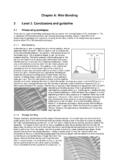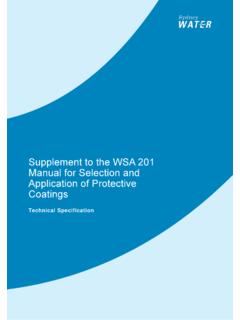Transcription of Polysiloxanes - Swerea IVF
1 Polysiloxanes Norman R. Mowrer Ameron international Performance Coatings and Finishes Inorganic silicon based polymers are inherently resistant to temperature, ultraviolet light and oxidation and are used as coating binders in the formulation of heat resistant silicones and zinc silicate primers. Many attempts have been made to utilize this chemistry to improve the properties of both inorganic and organic coatings. Progress has been slow primarily because of problems associated with film formation and the inability to obtain a balanced set of performance properties.
2 Recent advances in siloxane chemistry and formulation technology have led to the development of ambient temperature curable polysiloxane coating systems with significant advantages compared to traditional inorganic and organic coatings. Polysiloxanes are generally recognized as the newest generic class of high performance protective coating and include coating types based on inorganic siloxane and organic-inorganic siloxane hybrids. polysiloxane coatings based on pure inorganic siloxane binder are curable at ambient temperature and have high solids and low VOC, excellent temperature resistance and good resistance to certain acids and solvents.
3 They are well suited for high-heat and selected chemical lining applications. Semigloss highly weatherable topcoats have also been formulated using this technology. Polysiloxanes based on organic-inorganic siloxane hybrid binders have high solids and low VOC and provide an improved level of performance compared to traditional organic coating systems. Acrylic siloxane hybrids have superior weatherability and offer a cost effective, isocyanate-free alternative to aliphatic polyurethane topcoats. The epoxy siloxanes have very high solids and low VOC.
4 They have outstanding resistance to corrosion and better weatherability than aliphatic urethane. These properties allow a single coat of epoxy siloxane to replace the standard 2-coat, epoxy/urethane system currently used over zinc rich primer systems. Elimination of the extra coat and the superior durability of the epoxy siloxane system provide lower application and life cycle costs compared to the traditional zinc/epoxy/urethane 3-coat systems. TERMINOLOGY For clarity, Table 1 gives definitions of the chemical terminology used in this chapter.
5 In coating compositions, the typical resins containing the silicon-oxygen bond as repeating unit in the backbone are silicates, silicones, oxysilanes and siloxanes. Silicates are binders based on alkali metal salts of silicon-oxygen anions. Silicones are siloxane polymers with predominately two organic substituents on the silicon atom. Polysiloxanes by Norm Mowrer November, 2003 Oxysilane generally refers to silicon-based structures in which silicon is bonded with up to four alkoxide or hydroxyl groups, which enable certain condensation reactions.
6 Oxysilanes can be monomeric or polymeric. Silanes are monomeric silicon compounds with four substituents, or groups, attached to the silicon atom. These groups can be the same or different and nonreactive or reactive, with the reactivity being inorganic or organic. Inorganic reactive silanes have alkoxysilane groups and undergo hydrolytic polycondensation reactions. Organic reactive silanes contain amine, vinyl, epoxy, isocyanate or other functional groups that enable reactions with organic functionalities.
7 The term polysiloxane can include silicones but it is used herein in its broadest sense, that is, any polymeric structure that contains repeating silicon-oxygen groups in the backbone, side chains or cross links regardless of the substitution on the silicon atom. The presence of certain organic groups attached to the silicon atom in silicone and polysiloxane binders moderates physical, mechanical and chemical properties, typically in an advantageous way. HISTORY Inorganic Siloxane Coatings Inorganic silicon based polymers have been used as coating binders for more than 50 years and there are a number of excellent reviews on the subject1,2,3.
8 Heat curable zinc silicate primers were first introduced in the 1940 s. Waterborne zinc silicate primers that required post-cure with acid solution were commercialized in the 1950 s. Solvent based, ambient cure zinc-rich ethyl silicate primers became available in the 1960 s. Zinc silicates provide the highest level of corrosion protection. Silicone based coating formulations were developed during the same time period. The principal applications for these coatings included protective coatings for exhaust stacks, heat exchangers, boilers, ovens and furnaces, mufflers, cookware and aircraft components.
9 Silicate binders are not considered acceptable for broad use in coatings because of their poor film properties. Heat curing limited the practicality of silicone coatings, particularly on large structures. A significant advance was made in 1978 with the introduction of ambient cure binders based on the hydrolysis of trialkoxysilane4. Subsequent development of new silane and silicate precursors led to formulation of polysiloxane coatings with improved film properties. Well formulated polysiloxane coatings based on these binders are capable of providing long term resistance to heat in excess of 1400F (760C) and are resistant to continuous immersion in virtually all solvents and most organic and mineral acids.
10 - 2 - Polysiloxanes by Norm Mowrer November, 2003 Organic - Inorganic Siloxane Hybrid Coatings The first specification and earliest example of hybrid organic-inorganic coating is TT-E-490 (Enamel, Silicone Alkyd Copolymer). It was replaced by MIL-E-24635 (Enamel, Silicone Alkyd Copolymer), which is still used by the Navy and other government agencies as a weatherable topcoat on ships. Industrial analogs are used for the protection of tanks, chemical process equipment, bridges and other steel structures.








